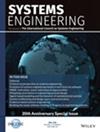用于验证作为功能代理的体系结构属性的实验框架
IF 1.6
3区 工程技术
Q4 ENGINEERING, INDUSTRIAL
引用次数: 1
摘要
期望的系统操作,被理解为生命周期属性,通常驱动系统体系结构的价值。然而,在体系结构用系统设计实例化之前,在系统体系结构开发过程中很难预测漏洞。在本文中,提出了一个实验框架,可以用来验证使用体系结构属性作为操作系统代理的充分性。实验框架建立在情感的理论化、通用概念化的基础上,这有助于正式证明在预测架构选择如何影响系统情感方面的困难和局限性。实验框架的应用通过一个概念场景展示,其中该框架用于评估不同的系统拓扑如何影响系统的可积性。本文章由计算机程序翻译,如有差异,请以英文原文为准。
An experimentation framework for validating architectural properties as proxies for the ilities
Desired system ilities, understood as lifecycle properties, generally drive the value of a system's architecture. However, ilities are hard to predict during system architecture development before the architecture has been instantiated with a system design. In this paper, an experimentation framework that can be employed to validate the adequacy of using architectural properties as proxies for ilities is presented. The experimentation framework builds upon a theoretical, generic conceptualization of ilities, which helps to formally justify the difficulties of and limitations in predicting how architectural choices influence system ilities. Application of the experimental framework is showcased with a notional scenario, where the framework is used to evaluate how different system topologies influence the integrability of a system.
求助全文
通过发布文献求助,成功后即可免费获取论文全文。
去求助
来源期刊

Systems Engineering
工程技术-工程:工业
CiteScore
5.10
自引率
20.00%
发文量
0
审稿时长
6 months
期刊介绍:
Systems Engineering is a discipline whose responsibility it is to create and operate technologically enabled systems that satisfy stakeholder needs throughout their life cycle. Systems engineers reduce ambiguity by clearly defining stakeholder needs and customer requirements, they focus creativity by developing a system’s architecture and design and they manage the system’s complexity over time. Considerations taken into account by systems engineers include, among others, quality, cost and schedule, risk and opportunity under uncertainty, manufacturing and realization, performance and safety during operations, training and support, as well as disposal and recycling at the end of life. The journal welcomes original submissions in the field of Systems Engineering as defined above, but also encourages contributions that take an even broader perspective including the design and operation of systems-of-systems, the application of Systems Engineering to enterprises and complex socio-technical systems, the identification, selection and development of systems engineers as well as the evolution of systems and systems-of-systems over their entire lifecycle.
Systems Engineering integrates all the disciplines and specialty groups into a coordinated team effort forming a structured development process that proceeds from concept to realization to operation. Increasingly important topics in Systems Engineering include the role of executable languages and models of systems, the concurrent use of physical and virtual prototyping, as well as the deployment of agile processes. Systems Engineering considers both the business and the technical needs of all stakeholders with the goal of providing a quality product that meets the user needs. Systems Engineering may be applied not only to products and services in the private sector but also to public infrastructures and socio-technical systems whose precise boundaries are often challenging to define.
 求助内容:
求助内容: 应助结果提醒方式:
应助结果提醒方式:


